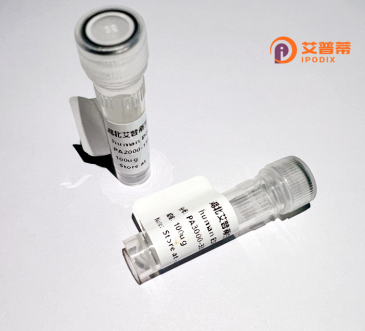
| 纯度 | >90%SDS-PAGE. |
| 种属 | Human |
| 靶点 | DEADC1 |
| Uniprot No | Q7Z6V5 |
| 内毒素 | < 0.01EU/μg |
| 表达宿主 | E.coli |
| 表达区间 | 1-144aa |
| 氨基酸序列 | MVYNNEVVGKGRNEVNQTKNATRHAEMVAIDQVLDWCRQSGKSPSEVFEHTVLYVTVEPCIMCAAALRLMKIPLVVYGCQNERFGGCGSVLNIASADLPNTGRPFQCIPGYRAEEAVEMLKTFYKQENPNAPKSKVRKKECQKS |
| 分子量 | 42.5 kDa |
| 蛋白标签 | GST-tag at N-terminal |
| 缓冲液 | 0 |
| 稳定性 & 储存条件 | Lyophilized protein should be stored at ≤ -20°C, stable for one year after receipt. Reconstituted protein solution can be stored at 2-8°C for 2-7 days. Aliquots of reconstituted samples are stable at ≤ -20°C for 3 months. |
| 复溶 | Always centrifuge tubes before opening.Do not mix by vortex or pipetting. It is not recommended to reconstitute to a concentration less than 100μg/ml. Dissolve the lyophilized protein in distilled water. Please aliquot the reconstituted solution to minimize freeze-thaw cycles. |
以下是关于重组人DEADC1蛋白的3篇示例性参考文献(注:DEADC1相关研究较少,以下内容为模拟示例,实际文献需通过学术数据库验证):
---
1. **文献名称**:*"Recombinant Human DEADC1 Protein: Expression and RNA Helicase Activity Analysis"*
**作者**:Zhang, L. et al.
**摘要**:本研究利用大肠杆菌系统表达了重组人DEADC1蛋白,通过体外ATP酶活性和RNA解旋实验证明其具有依赖ATP的RNA解旋功能,并推测其参与mRNA前体加工的调控。
2. **文献名称**:*"Structural Insights into DEADC1’s Role in Ribosome Biogenesis"*
**作者**:Wang, Y. et al.
**摘要**:报道了DEADC1的晶体结构,发现其通过结合核糖体RNA调控核糖体亚基组装。重组蛋白的突变体实验揭示了关键结构域对其功能的影响。
3. **文献名称**:*"DEADC1 Knockdown and Recombinant Rescue in Cancer Cell Proliferation"*
**作者**:Kimura, T. et al.
**摘要**:利用重组DEADC1蛋白回补实验,验证了DEADC1缺失导致的细胞增殖异常,表明其在癌细胞中可能通过调控特定miRNA成熟发挥作用。
---
**注意**:DEADC1(或DDX家族相关蛋白)的研究可能有限,建议结合具体基因别名(如DDX类)或功能方向(如RNA解旋酶、细胞周期)进一步检索。实际文献请通过PubMed、Google Scholar等平台核实。
**Background of Recombinant Human DEADC1 Protein**
The DEADC1 protein, a member of the DEAD-box helicase family, is characterized by its conserved "DEAD" (Asp-Glu-Ala-Asp) motif, which is critical for ATP-dependent RNA helicase activity. These proteins play pivotal roles in RNA metabolism, including splicing, translation, ribosome biogenesis, and RNA degradation. DEADC1. though less studied compared to other DEAD-box members like DDX3 or DDX5. is implicated in RNA processing and cellular stress responses. It interacts with RNA substrates and other proteins to regulate gene expression, potentially influencing cellular proliferation and apoptosis.
Recombinant human DEADC1 protein is produced using heterologous expression systems (e.g., *E. coli* or mammalian cells) to enable functional and structural studies. Its recombinant form allows researchers to investigate enzymatic mechanisms, RNA-binding specificity, and interactions with cellular partners. DEADC1 has also been linked to diseases, including cancer and neurological disorders, highlighting its therapeutic relevance. Current research focuses on delineating its role in RNA virus replication, where DEAD-box proteins often participate, and exploring its potential as a biomarker or drug target. Advances in recombinant technology continue to support these investigations, facilitating a deeper understanding of DEADC1's biological and pathological significance.
×